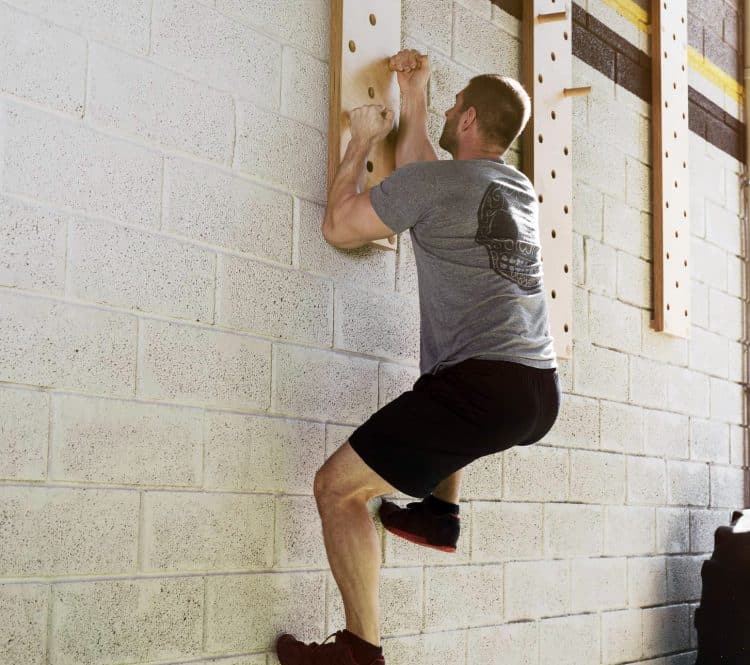Does your gym have a pegboard? Or are you thinking of buying one for your home gym? Either way, this old-school training tool is going to kick your butt!
Climbing a pegboard is an excellent workout for your upper body. It is especially useful for rock climbers, gymnasts, grapplers, and anyone else who needs to develop pulling strength and an unbreakable grip.
However, because of the risk of falling, you must know what you are doing before you embark on your first pegboard ascent. Remember, what goes up must come down!
In this guide, we explain why and how to climb a pegboard and reveal the alternative exercises you can do instead.
Pegboard Climbing – Muscles Worked
Climbing a pegboard is a compound movement, meaning it involves several joints and muscles working together. The main muscles involved in using a pegboard are:
Level Up Your Fitness: Join our 💪 strong community in Fitness Volt Newsletter. Get daily inspiration, expert-backed workouts, nutrition tips, the latest in strength sports, and the support you need to reach your goals. Subscribe for free!
Latissimus dorsi
Located on the side of your upper back, the lats are basically your wings. The lats will be doing most of the work when you train on a pegboard. The functions of the lats are extension and adduction of the shoulders, and both movements occur during pegboard climbing.
Biceps brachii
Known as the biceps for short, these muscles are located on the front of your upper arms. The main functions of the biceps are flexion of the elbow and supination of the forearm. Expect a great biceps workout from climbing a pegboard.
Trapezius and rhomboids
The trapezius and rhomboids are your upper back muscles. Located across and between your shoulder blades, they help pull your shoulders back and together during pegboard climbing. This provides a strong, stable platform for your arms to work from.
Deltoids
The deltoids are your shoulder muscles. They’re made up of three sets of fibers, commonly called heads. These are anterior (front), medial (middle), and posterior (rear). The rear deltoids are the most active during a pegboard climb, but the medial and anterior deltoids are also involved as they work to stabilize your shoulders.
Forearms
Pegboard climbing provides your forearms and grip with an excellent workout. The success of your ascent is highly dependent on how tightly you can hold the pegs. Some boards have thick or even rounded pegs to make climbing even more forearm-centric.
Core
Core is the collective name for the muscles of your midsection, including the rectus abdominis, obliques, transverse abdominis, and erector spinae. Climbing a pegboard involves plenty of lateral or side-to-side movement, and you’ll need to use your core to stabilize your lower body and prevent your legs from swinging out of control.
How to Climb a Pegboard
Get more from peg board climbing while keeping your risk of injury to a minimum by following these guidelines:
- Insert your pegs into holes, so they’re approximately eye-height. Grip the pegs, so your arms are bent to around 90 degrees and your palms are turned inward.
- Brace your abs and pull your shoulders down and back. Lift your feet off the floor.
- Supporting your weight on one arm, shift your weight over and remove the other peg from the board. Reach up and reinsert the peg a little higher up.
- Shift your weight to the other side and remove the second peg from the board. Again, reach up and reinsert it further up the board.
- Pull yourself up and repeat.
- Continue this motion until you a) reach the top or b) perform the prescribed number of movements.
- Next, slowly descend using the same alternating arm action, only this time in reverse.
- Continue until you are back on the ground.
Tips:
- Move the pegs up using small steps – longer steps are far harder and require much more strength.
- Keep your elbows bent to around 90 degrees, and keep your upper arms close to your sides to maximize strength and minimize the risk of injury.
- Use lifting chalk to stop your hands from sweating and slipping.
- Don’t leave the pegs in the top of the board – you may need to use a ladder to retrieve them if you do!
- Don’t feel you HAVE to ascend all the way to the top. Even a few feet of climbing will be enough if you are a beginner.
- You can use your feet for assistance if necessary, but ideally, you should climb the pegboard using only your arms.
Pegboard Climbing Benefits and Drawbacks
Not sure if pegboard climbing deserves a place in your workouts? Consider these benefits and then decide!
A functional upper body workout
Many so-called functional exercises are not truly functional. When was the last time you needed to balance on one leg while curling a weight to your shoulders?
However, pegboard climbing uses your back, biceps, and forearms in a very natural way. As such, this is a great movement for improving functional pulling power. It’s an excellent exercise for athletes from all sports.
Variety
Are you bored of doing the same old pulldowns, pull-ups, and curls for your back and biceps? Climbing a pegboard works all of the same muscles but in a completely unique way. Shake up your dull upper body workouts by adding pegboard climbing into the mix.
Better coordination
Climbing a pegboard is as much a test of skill as it is strength. You need to carefully coordinate your movements to ensure the pegs go in the holes. Misses will make your workout even more exhausting. You’ll also need to maintain your coordination as you begin to tire. This is another reason that pegboard climbing is such a good exercise for athletes.
Determination
It can be a real slog to climb to the top of a pegboard. Unlike most exercises, where you can stop your set when you get tired, you can’t just quit partway up a pegboard. Instead, you’ll need to grit your teeth and push onward. Then, after climbing as high as you can, you still need to climb back down. Your determination and mental toughness are bound to improve with a few pegboard workouts!
Identify and fix and left to right strength imbalances
Most vertical pulling exercises involve using both arms at the same time, i.e., pull-ups and pulldowns. This can disguise and cause left-to-right strength imbalances. The alternating arm action used during pegboard climbing will expose any such weaknesses and provides a great way to fix them.
A popular exercise in CrossFit
Pegboards have been around for decades but have recently seen a resurgence in popularity thanks to things like Ninja Warrior and CrossFit. While this isn’t necessarily a benefit, it’s always nice to get in on the ground level when a new fitness trend launches!
While pegboard climbing is a mostly beneficial exercise, there are also a few drawbacks to consider:
Risk of falling
Falls from pegboards are not uncommon, and all it takes is a missed peg placement, a slippery hand, or forearm fatigue. Ideally, there should be a soft, clear landing area below your peg board, so you won’t hurt yourself if you fall.
Fear of heights
For some people, climbing a pegboard is as much a test of bravery as it is of strength. If you are scared of heights, the pegboard may not be the ideal workout for you. Keep your feet on the floor and do lat pulldowns instead.
Short range of motion
The best way to climb a pegboard is with your elbows bent to 90 degrees and your upper arms close to your sides. This is a powerful position that’s also safer for your joints. However, your elbows and shoulders are capable of much larger movements, so too much pegboard climbing could reduce your mobility and flexibility.
Avoid problems by ensuring that the rest of your workouts involve full range overhead and arm extension.
7 Pegboard Climbing Variations and Alternatives
Pegboard climbing is a highly effective upper-body exercise, but that doesn’t mean you need to do it all the time. There are several variations and alternatives you can use to keep your workouts productive and interesting:
1. Pegboard dead hang
The dead hang is a great way to get started with pegboard training. Dead hangs will strengthen your grip and get you used to using the pegs to support your weight. And, because you stay close to the floor, falling is not an issue.
Steps:
- Insert your pegs into the board and then grip them tightly.
- Pull your shoulders down and back, and brace your abs.
- Lift your feet off the floor and keep them up for as long as possible.
- Lower your feet to the floor just before your grip fails.
- Rest, shake out your arms, and repeat.

Muscles targeted:
- Primary: Latissimus dorsi, biceps, forearms.
- Secondary: Core, trapezius, rhomboids, deltoids.
Benefits:
- A safe way to build enough strength to climb a pegboard.
- An excellent isometric biceps, lats, and grip exercise.
- Good for anyone who prefers to stay closer to the ground!
Tips:
- Do this exercise with bent and straight arms to ensure you work your muscles from all the available angles.
- Do not hold your breath.
- Use chalk to maximize your grip.
2. Pegboard traverse
Pegboards are sometimes mounted horizontally instead of vertically. This means you can travel along them instead of up and down. Horizontal traveling is called traversing. This is a good option when there is insufficient headroom for climbing upward or you just want to stay closer to the ground. Traversing is a good choice for beginners who may be unsure if they can safely reach the top and then descend a vertically mounted board.
Steps:
- Insert the pegs into the board and grip them with your palms facing inward. Contract your arms, lats, and abs, and lift your feet off the floor.
- Remove the peg on the side you wish to travel in and reinsert it a little further along the board.
- Remove the second peg and move it down the board.
- Continue alternating arms until you have traveled as far as desired.
Muscles targeted:
- Primary: Latissimus dorsi, biceps, forearms.
- Secondary: Core, trapezius, rhomboids, deltoids.
Benefits:
- A safe and effective alternative to climbing a vertical pegboard.
- No risk of falling.
- A good option for gyms with no room for a vertical pegboard.
Tips:
- Use your feet for extra support if necessary.
- You can do this exercise with flexed or semi-straight arms.
- Swing your legs in time with your arm movements to unload each peg and make them easier to remove.
3. Staggered pull-ups
Pull-ups are invariably performed with both hands at the same level. However, if you are a climber or play contact sports, you’ll often have to use your pulling muscles with one hand higher than the other, i.e., a staggered grip. This unique exercise mirrors those unusual demands.
Steps:
- Set up your pegboard so that the handles are roughly shoulder-width apart and one is 8-12 inches above the other.
- Grip the handles and hang with your arms straight, core braced, and shoulders down and back.
- Bend your elbows and pull yourself up until your eyes are level with your hands.
- Descend under control and repeat for the desired number of reps.
- Rest a moment and repeat. Make sure you switch the handles around from set to set to work both sides equally.
Muscles targeted:
- Primary: Latissimus dorsi, biceps, forearms.
- Secondary: Core, trapezius, rhomboids, deltoids.
Benefits:
- An entertaining and effective pull-up alternative.
- A great way to emphasize one arm at a time.
- A good gateway exercise to pegboard climbing.
Tips:
- The more level the handles, the easier this exercise becomes.
- Keep your core braced to stabilize your lower body. Less swinging means a more effective workout.
- Wear a weighted vest or use a chin/dip belt to make this exercise more challenging.
4. Towel climbs
Towel climbs are the perfect exercise for anyone who wants to use a pegboard but doesn’t have access to one. They use the same muscles and even look and feel very similar. All you need for this exercise is an old gym towel and a pull-up bar.
Steps:
- Hang your gym towel over the middle of a smooth pull-up bar.
- Hold the ends and hang with your feet off the floor.
- Pull your shoulders down and back, and brace your abs.
- Bend and pull down with one arm and lift the opposite knee.
- Then, pull down with your opposite arm and lift your other knee.
- Continue pulling with an alternating arm action for the required number of reps.
Muscles targeted:
- Primary: Latissimus dorsi, biceps, forearms.
- Secondary: Core, trapezius, rhomboids, deltoids.
Benefits:
- A gym-friendly alternative for pegboard climbing.
- A challenging alternative to pull-ups and chin-ups.
- An excellent exercise for building a stronger grip, back, and biceps.
Tips:
- The thicker the towel, the harder it will be to grip. Choose a towel that matches your current grip strength.
- Shift your weight from side to side as you pull with your arms to mimic using a pegboard more closely.
- Tie knots at the end of your towel if you need a more secure, reliable grip.
5. Monkey bar traverse
While not as challenging or skillful as pegboard climbing or traversing, swinging from rung to rung on an overhead ladder or monkey bars is still a great workout. A few sets of this exercise, and you’ll discover a whole new level of lat and grip fatigue!
Level Up Your Fitness: Join our 💪 strong community in Fitness Volt Newsletter. Get daily inspiration, expert-backed workouts, nutrition tips, the latest in strength sports, and the support you need to reach your goals. Subscribe for free!
Steps:
- Using an overhand grip with or without your thumb around the bar, hang from the first rung of your bars. Your arms should be straight but not relaxed. Pull your shoulders down and back.
- Release one hand and move it forward to grab the next rung.
- Then, swing forward with your other arm and grab the next rung.
- Continue along the bars until you reach the end.
- Stop and rest or turn around and go back across the bars.
Muscles targeted:
- Primary: Latissimus dorsi, biceps, forearms.
- Secondary: Core, trapezius, rhomboids, deltoids.
Benefits:
- Fun, fun, fun – it’s a workout in disguise!
- Good for improving eye-hand coordination.
- A good pegboard climbing alternative for people who don’t like heights.
Tips:
- Miss every other rung and take longer swings to make this exercise more challenging.
- Go sideways or even backward for variety.
- Give two-handed rung-to-rung jumps a try, like this:
6. Neutral fat-grip pull-ups
Most pegboard handles are thicker than the average barbell. While this makes them a little more joint-friendly, it also means they’re far harder to grip. Condition your forearms before you try pegboard climbing with neutral fat-grip pull-ups.
Steps:
- Hold the parallel (neutral) grips on your pull-up bar, so your palms face inward.
- Hang with your arms straight, shoulders down and back, and core braced. Grip the bars as hard as possible.
- Bend your elbows and pull your chin up toward your hands. Drive your elbows down and behind you to maximize back engagement.
- Lower yourself down smoothly and repeat.
Muscles targeted:
- Primary: Latissimus dorsi, biceps, forearms.
- Secondary: Core, trapezius, rhomboids, deltoids.
Benefits:
- More elbow-friendly than overhand grip pull-ups or underhand chin-ups.
- An excellent grip, back, and biceps exercise.
- An accessible exercise as most gyms have neutral grip pull-up bars.
Tips:
- Make this exercise harder by wearing a weighted vest or using a chin/dip belt.
- No fat bars at your gym? No problem! Wrap the bar with a towel or sponges to make it thicker and harder to grip.
- Pull your chest up to the bar to increase lat, rhomboid, and trapezius recruitment.
7. Dumbbell hammer curls
While we’re the first to admit hammer curls don’t look anything like pegboard climbing, they do work your biceps and forearms in much the same way, i.e., in a neutral position. So, if climbing a pegboard is too hard for you at the moment, build your strength with hammer curls.
Steps:
- Hold a dumbbell in each hand, arms by your sides. Your thumbs should be pointing forward. Pull your shoulders back and down and brace your core.
- Without using your legs or back to swing the weights up, bend your elbows and raise the dumbbells to shoulder level.
- Return the weights to the starting position and repeat.
Muscles targeted:
- Primary: Biceps, brachialis, brachioradialis.
- Secondary: N/A.
Benefits:
- An excellent preparatory exercise for pegboard climbing.
- An effective way to build and strengthen your biceps and forearms.
- A more elbow-friendly exercise than straight bar curls.
Tips:
- You can also do this exercise with an alternating arm action.
- Do this exercise without your thumbs wrapped around the bar for a more grip-intensive workout.
- Use fat grips to make this exercise more pegboard-specific.
FAQs
Do you have a question about pegboard climbing? No problem, because we’ve got the answers!
1. Is pegboard climbing a good way to build muscle?
Pegboard climbing may help you build muscle, but it’s probably better for increasing strength and muscular endurance. The most effective hypertrophy exercises take your muscles through a large range of motion and involve a loaded stretch. Pegboard climbing does neither of these things.
However, climbing a pegboard does put your muscles under a lot of tension for an extended time, which is why they’re good for improving performance.
There is a reason that bodybuilders do exercises such as pull-ups and lat pulldowns for their back muscles – they’re the most effective exercises for increasing mass. You probably won’t see many bodybuilders climbing a pegboard.
2. What is a campus board?
You’ll often find campus boards and pegboards together. They’re both used by climbers for indoor training. Where pegboards have removable handles, a campus board has fixed rungs. Both are climbed using just the arms to build upper body strength and a better grip.
Campus boards are so-called because they’re popular on university campuses, and student climbers often have one in their dorm room.
However, while athletes from all sports can benefit from pegboard climbing, campus board training is only really of benefit to rock climbers.
3. Is pegboard climbing safe?
Pegboard climbing is relatively safe. Done correctly, your arms remain flexed at around 90 degrees with your upper arms pulled in close to your sides. This is a very strong, stable position. The range of motion at the shoulders and arms is also small and controlled, which should further improve safety.
The biggest danger associated with pegboard climbing is the risk of falling. However, the average board is not that tall, so falls are not usually all that great.
Pegboards are pretty safe, and many high school gyms have them. They were once also a regular part of PT classes:
4. How do I get better at pegboard climbing?
The best way to get good at something is to do it often. Practice climbing a pegboard, and your performance will improve.
That said, a few additional strategies for getting better at pegboard climbing include:
Lose weight – pegboard climbing is a test of relative strength, which is your strength compared to your body weight. Therefore, losing weight will make the exercise easier, as you won’t have to work so hard to haul yourself off the ground.
Beef up your biceps – keeping your arms locked off at 90 degrees requires lots of biceps strength. Strengthen your biceps with barbell and dumbbell curls, hammer curls, reverse curls, and neutral grip pull-ups to prevent your biceps from becoming the weak link in your pegboard climbing chain.
Focus on training quality and not quantity – practice makes perfect, and if you want to get better at pegboard climbing, you need to practice often. That means NOT training to failure, which would limit the volume and frequency of your workouts.
Instead, stop each set as you start to feel tired but still have more gas in the tank. This will allow you to do more ascents per workout and improve your performance faster.
5. Got any good CrossFit pegboard workouts?
Sure do! Try these on for size…
Pedal to the Metal – CrossFit Games 2015
One round for time:
- 3 pegboard ascents
- 24-calorie row
- 16-calorie bike
- 8 dumbbell squat snatches (100/70lb)
Time cap: 6 minutes
Redemption – CrossFit Games 2016
For Time:
- 3 pegboard ascents
- 21 thrusters (135/85lb)
- 2 pegboard ascents
- 15 thrusters (135/85lb)
- 1 pegboard ascent
- 9 thrusters (135/85lb)
Time cap: 10 minutes
Pegboard Heavy DT
5 rounds for time:
- 12 deadlifts (185/135lb)
- 9 hang power cleans (185/135lb)
- 6 shoulder to overhead (185/135lb)
- 3 unbroken pegboards (touch-n-go, no coming off)
Wrapping Up
Pegboards are very low-tech, but that doesn’t stop them from being a fun and effective upper-body workout. Climbing a pegboard works your entire upper back and arms; even your core gets a piece of the action.
Athletes have been using pegboards for decades to build upper body strength and endurance, and they’re especially valued by rock climbers. They’ve become part of CrossFit, featuring in several high-profile WODs, and pegboards are popular for home gyms, too.
While climbing a pegboard won’t give you a bodybuilder-sized back, it will develop functional strength and an unbreakable grip. So, if you are looking for a new training challenge, give pegboard climbing a try.
Interested in measuring your progress? Check out our strength standards for Dumbbell Curl, Pull Ups, Clean, and more.









